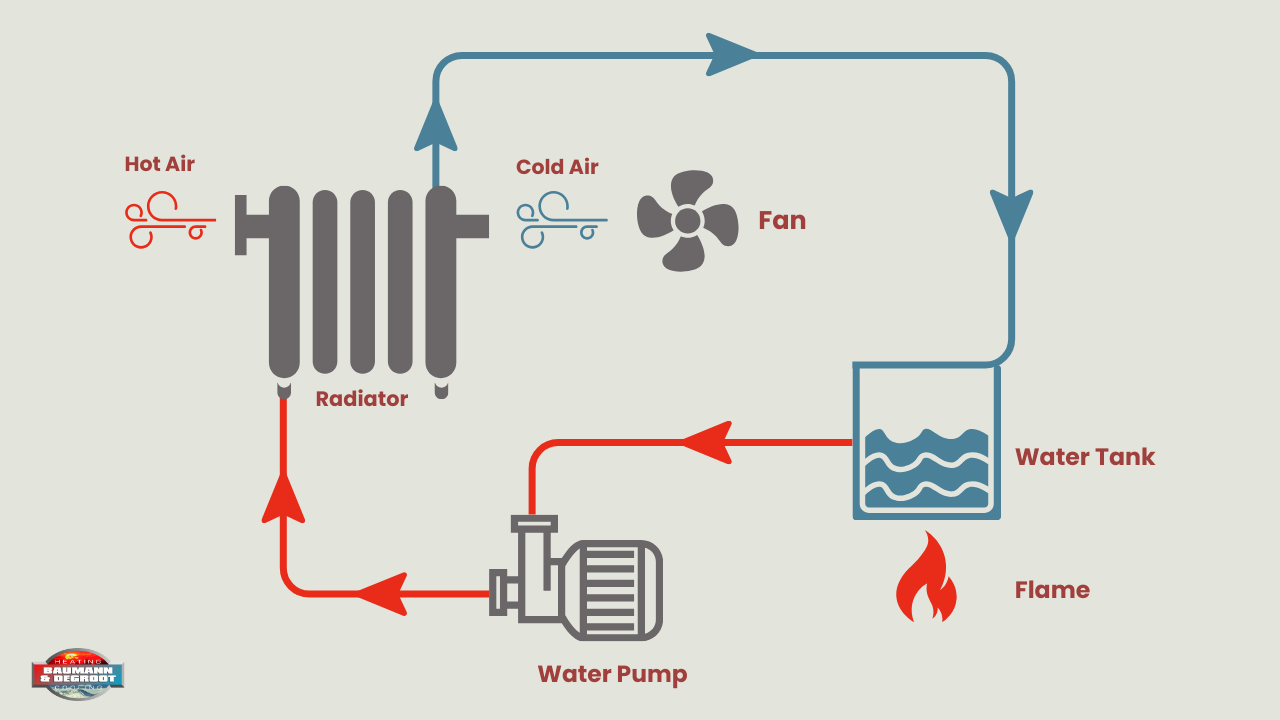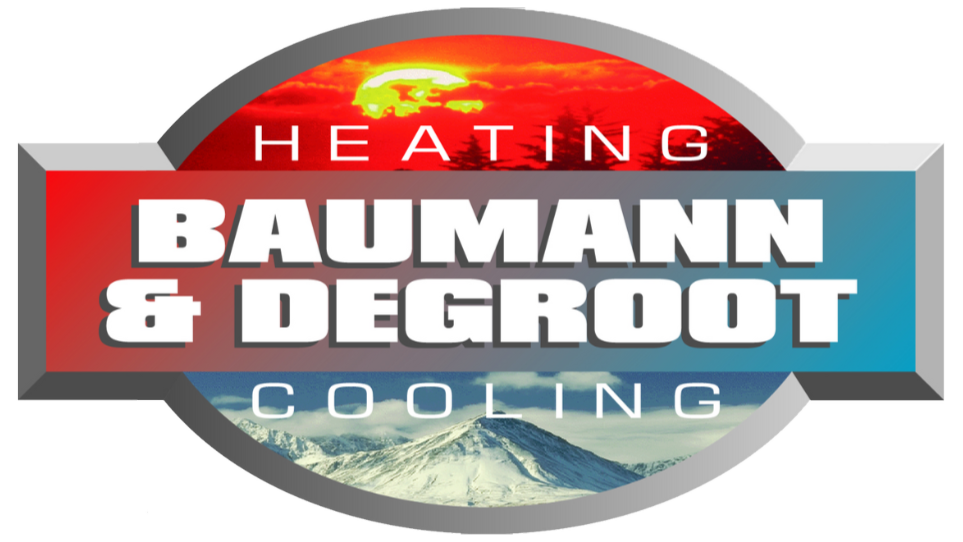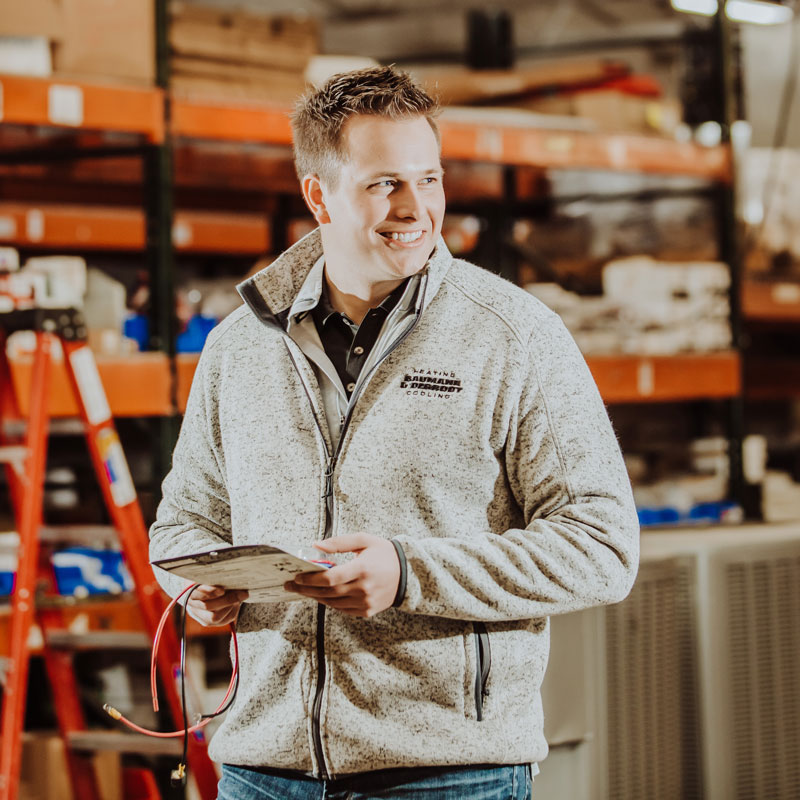How to Understand a Heat Pump Diagram
When you look at a heat pump diagram, it may seem complex at first. However, once you grasp the basic concept, it’s surprisingly simple (and you will by the time you finish reading this!). As its name suggests, a heat pump transfers or “pumps” heat from one place to another. The key word here is pump—instead of generating heat, it efficiently moves it where it’s needed.
Understanding The Basics:
As they say, “a picture is worth a thousand words.” So let’s break down the basic concept of a heat pump diagram:
- The flame heats up the water.
- The hot water is pumped to the radiator.
- The fan forces the cold air over the hot radiator, and the air becomes hot.
- The water is now cold because the heat has been transferred from the water to the air. The cold water is then pumped back to the water tank where it is heated up again (Step 1).
- Notice in this example that the flame generates the heat. We transfer that heat to the air using a medium (in this case the water) pumped through a radiator. Pumped heat—a heat pump!
- The real heat pump doesn’t differ that much from this simple example, we just replace the water with a refrigerant and replace the water pump with a compressor.

You may notice this diagram looks similar to an air conditioner…does that mean a regular air conditioner is considered to be a heat pump?
Let’s See:
- Heat is generated inside your house from the sun shining through windows, appliances, and your body. This is the equivalent of the flame heating the water in our first example.
- Your air conditioner transfers that heat from inside your house to outside your house. This is the equivalent of the pump and radiator.
In theory: yes, any regular air conditioner can be considered to be a heat pump (but don’t tell this to your repair man or you will confuse him)!
So what is the difference between your regular air conditioner and a heat pump?
The Real Heat Pump In Action
Cooling Mode (Regular Air Conditioning)

First, notice 3 things:
- The position of the reversing valve.
- The direction of the flow of the refrigerant.
- The inlet and outlet ports of the compressor—those will never change.
Did you notice?
OK—Let’s start at point 1 on the diagram:
- Point 1: At the beginning of the cycle the refrigerant is in a liquid form (gas contained under pressure becomes a liquid just like the propane in the tank that you use to BBQ that juicy steak) This liquid refrigerant is very cold. It enters the evaporator coil located inside your house. The hot air in your house moves over the coil and the air starts to lose its heat and cool down.
- Point 2: After the refrigerant leaves the indoor evaporator coil, it absorbs heat and becomes gas. Just like when you heat water on the stove and it becomes steam, the refrigerant gas evaporates when it absorbs all that heat in the house (that’s why we call this coil the evaporator). The refrigerant enters the compressor which mechanically pressurizes the gas. The process will increase its temperature so the refrigerant will leave the compressor as hot gas.
- Point 3: The refrigerant next moves to the condenser coil, located outside the house. Because the temperature outside is lower than the temperature of the hot gas, the heat is transferred from the refrigerant in the coil to the outside air. As the temperature of the refrigerant gas cools, it will form liquid condensate–just like the water droplets that form on a cold glass of soda (that’s why we call this coil the condenser).
- Point 4: The refrigerant leaves the outdoor condenser coil as warm liquid. Now we need to make the warm liquid refrigerant cold so that it can absorb more heat, so it goes to the metering device which drops the pressure on the warm liquid and thus drops its temperature. The refrigerant leaves the metering device as a cold liquid, ready to repeat the cycle again.
Heating Mode
Now what about heating–how does that work?
Let’s look at the next diagram:

Did you notice what just happened?
Here are the two diagrams, side by side. Look carefully this time:

Look at the reversing valve—it rotates 90 degrees, changing the direction of the refrigerant flow. It goes in the opposite direction and this is the reverse of the cooling cycle. Instead of absorbing heat from inside the house it absorbs heat from the air outside and transfers that heat to the indoor air. Now the indoor coil has become the condenser, and the outdoor coil has become the evaporator. The air conditioner does not have the reverse valve, which is the main difference between the heat pump and the air conditioner.
Notice that the heat isn’t generated by an oil burner or a gas furnace. It is just moved (or pumped)from the outside air to inside the house. This is why the heat pump is so popular in moderate climates. You don’t need to have a furnace when the weather cools off. Because of the reversing valve, you can use the same electric system as both an air conditioner and a heater!
How Heat Pumps Function in Both Summer and Winter

Heat Pump Diagram Summary
That was a lot of information, so let’s summarize:
Heat pumps and air conditioners don’t generate heat—they simply move it. Like an air conditioner, a heat pump transfers heat from one place to another. The key difference is the reversing valve in a heat pump, which allows it to switch between cooling and heating modes. In cooling mode, heat is moved from inside your home to the outdoors, while in heating mode, the process is reversed to bring heat from outside into your home. Air conditioners lack this reversing valve and can only cool by transferring heat outside.
Understanding how heat pumps work can help you make informed decisions about your home’s comfort system. If you’re unsure which option is best for your needs or have questions about optimizing your current system, Baumann & DeGroot is here to help. Our team of experts is always ready to provide personalized guidance and ensure your home stays comfortable year-round. Don’t hesitate to reach out—we’re just a call away!
For trusted heating service and expert advice, reach out to Baumann & DeGroot today at (616)396-4328 or schedule online.


